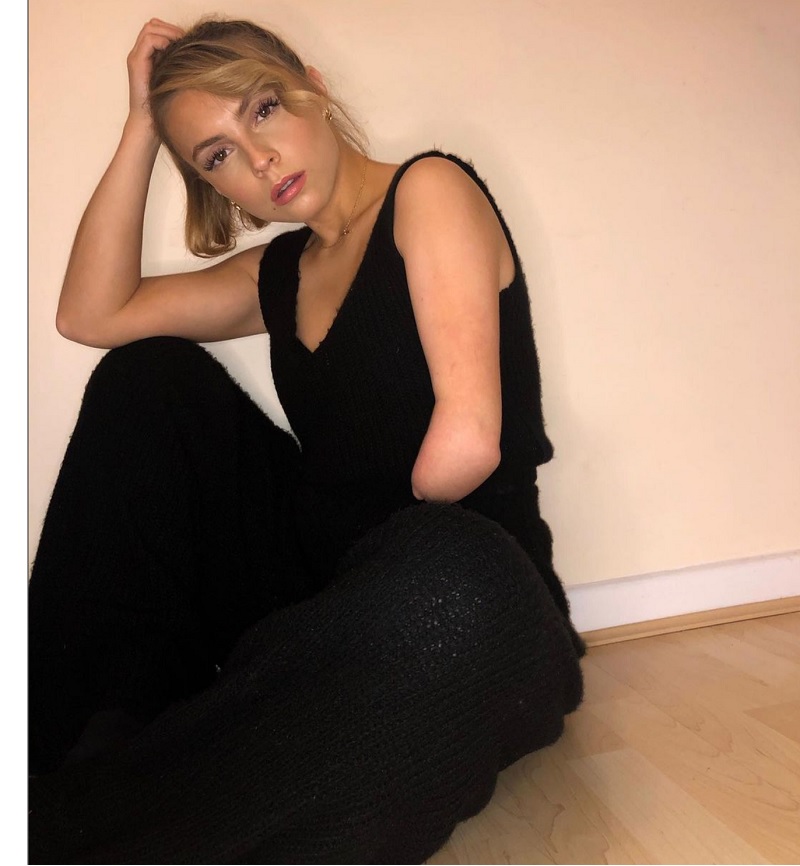“I want everyone to feel like it’s possible to chase after every single one of their dreams,” says Kayla Maria G, the model who graces the cover of our current issue. That’s a big part of why she models—to make a statement about inclusion, and to change how society perceives bodies that defy to conventional definitions of beauty.
The same mission drives her modeling agency, Zebedee Talent. Since its founding five years ago, the UK-based agency has assembled an international roster of amputee models who, like Kayla, are outspoken advocates for people with limb difference. Here are five rising Zebedee stars who are making an impact with their words as well as their images.
Gemma Adby

“I’ve been held back more by people’s expectations of me than I have by my disability,” Adby told a London website last year. She spent years trying to fit in and went out her her way to avoid drawing attention to her limb difference. But when she saw Kelly Knox proudly displaying her limb difference on Britain’s Missing Top Model and in subsequent ad campaigns for major brands, it completely altered Adby’s thinking. She volunteered to model for a friend who needed help with a college photography assignment, and things took off from there. Since signing on with Zebedee in 2020, she has landed contracts repping brands such as ASOS and Pretty Little Thing. Far from concealing her limb difference, Adby now puts it front and center. “I hope that by putting myself out there, I’ll be able to create awareness so that others who have been counted out will be given an opportunity,” she says. “I want to be the role model for children that I never saw as a child.” On Instagram @gemmaadby.
Madisyn Taute
One of two Zebedee models chosen to appear in Nike’s Go FlyEase promo video, the 23-year-old Taute has bagged some big-ticket clients in a short (so far) career. Target, Gatorade, and Patagonia have also run campaigns featuring the talented Iowa native, who says she felt like an outcast growing up. “I never talked about my hand, never talked about being different,” Taute told her hometown newspaper last year. “It made me feel insecure.” Then she attended a rock-climbing camp with SheLift, reality-TV star Sarah Herron’s outdoor-rec foundation for women with physical differences. That experience gave Taute the confidence not only to pursue a modeling career, but also to enter some rock-climbing competitions. She ended up making the national team last June and earning a medal in a World Cup event in October. “It’s taken me many years to grow into this level of comfort & confidence in my body,” Taute says. “I constantly felt embarrassed, shameful, alone, unworthy & hated.” Moving forward, she adds, “I don’t just want to be a model. I want to be a role model.” On Instagram @madisyn.taute.
Jaleesa Graham
Graham built her career slowly as a part-time model, making occasional appearances in ad campaigns (Lands End, Microsoft Surface), fashion shows (New York Fashion Week), and TV shows (Project Runway) while raising her two kids. Last year she broke through with her first network TV speaking role (on NBC’s New Amsterdam) and first full-page magazine ad (for Olay), while also gracing a high-profile Women’s Health layout and netting a host of social media promotions. It was the first year Graham earned enough to support herself and her family as a full-time model, but it won’t be the last. “Growing up, I always wanted to become a model,” she says, “[but] I was always discouraged because I never saw any models on the runway who looked like me. I thought I could not be a model because I didn’t ‘look’ like a model.” So much for that theory. On Instagram @jaleesagraham.
Alex Schwartz
“Growing up, I ignored my differences,” writes Schwartz (a congenital bilateral amputee) at his website. “Sure, I had to sit out in gym class . . . . but other than that, I didn’t mention it much, wore [long] pants often, and felt like this was just my fate.” But at age 18 he saw a commercial featuring a bilateral amputee in running blades, which got him interested in athletics. Now, a few years later, he is that amputee, pushing the limits in the Spartan Race and sharing his story in keynote addresses, conferences, social media videos, and beyond. Fresh off a video shoot in New York, he’s pursuing a triple-threat career as a model, social media influencer, and computer programmer. On Instagram @bionic.al.
Jessica Ping-Wild
Yes, she’s “wild,” but this disability advocate is more “sting” than “ping.” Known online as The Rolling Explorer, Ping-Wild has become an expert at skewering the indignities of an able-centric world with energy, sharp wit, and good humor. She’s one of only about 60 people worldwide to be diagnosed with CHILD syndrome (an acronym for Congenital Hemidysplasia with Ichthyosiform erythroderma and Limb Defects), a congenital condition that typically results in limb difference on one side of the body—the left side, in Ping-Wild’s case. When she’s not appearing in campaigns for Intimately, Invacare, and Just Eat (the UK’s answer to Door Dash), you can find her on online deconstructing the casual ableism encoded in architecture, language, media, civic infrastructure, and almost everywhere else in our culture. “DISABLED PEOPLE ARE NOT BURDENS,” she wrote recently. “But many people think we are burdens on our families, the government, employers, society in general. It’s exhausting. It’s why we have such a high unemployment rate. It’s why we are left out of the media and entertainment industries. Most importantly, though, it’s why we are not given adequate space to exist in the modern world.” On Instagram @therollingexplorer.